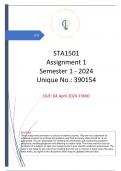2023
STA1501
Assignment 1
Semester 1 - 2024
Unique No.: 390154
DUE: 04 April 2024 23h00
Disclaimer
These study notes are meant to aid your academic journey. They are not a substitute for
individual research or professional guidance, and their accuracy, while strived for, is not
guaranteed. You are responsible for verifying the information and maintaining academic
integrity by avoiding plagiarism and adhering to citation rules. The notes may not cover all
variations of a subject, so tailor your assignments to your specific academic environment. The
seller is not liable for any outcomes resulting from the use or misuse of these notes. By using
these notes, you agree to this disclaimer, which may be updated without notice.
,FALSE. The module STA1501 listed for your degree at UNISA represents a sample, not a
population.
TRUE. A bar chart is commonly used to visualize qualitative variables.
STA1510 Study Guide, Page 6, 1.7 Study Unit 1: Summary
UnisaGuides
, FALSE. A population size in a particular area of Gauteng Province represents a discrete
quantitative variable, not a continuous one. This concept is discussed in Section 1 of the Study
Guide.
TRUE: A rating of a newly elected politician (such as “excellent,” “good,” “fair,” or “poor”)
represents an ordinal qualitative variable. You can find this in Section 1.
TRUE. The province in which a person lives represents a qualitative variable.
TRUE: In statistics, there are several methods to analyse data. Descriptive statistics methods
enable you to organize and summarize the data. This is covered in Section 3.
TRUE: The cumulative frequency table for the given data is as follows:
Class limits (5 − 9), (10 − 14), (15 − 19)
Total Frequency (51), (87), (120) respectively




